ABSTRACT
Exposure to dioxins is an especially challenging health threat in Viet Nam due to the country’s history of being subjected to aerial spraying with the 2,3,7,8, tetrachlorodibenzo(p)dioxin (TCDD)-contaminated defoliant Agent Orange and because of decades of pollution associated with rapid industrialization.
One Health is an approach that recognizes that humans, animals, and the environment are interconnected and as such can be used as a framework to study widely disseminated environmental toxicants such as dioxins. One Health strategies inform the role of contaminant transferal through the environment and enable comparison of the impacts to the health of animal and human populations and ecosystems. Here, we operationalize a One Health framework through the creation of a database describing the context for TCDD and dioxin contamination.
Preliminary findings from two of the database domains are reported in this paper. Using the Biota Domain, we have identified and reviewed papers (n=25 papers) of in-situ studies of TCDD contamination in biota in Vietnam. We present summary findings on geographic coverage of screening studies, taxonomic groups and species sampled, and specimen type, and infer plausible hazards and risks to public health based on bioaccumulation and food consumption patterns. The Human Domain currently has identified 44 papers with over 500 measurements. After geocoding, GIS methods were used to develop a spatio-temporal map of human dioxin exposure based on measurements of TCDD in blood serum, tissue, or breast milk.
Based on findings that highlight contamination through space and time, future directions include aggregating findings across species to allow for an improved ecological view of TCDD accumulation throughout the life cycle and food chain, determining whether there are knowledge gaps where targeted surveillance may be needed, and assessing TCDD risks to humans and within a conservation lens regarding any impacts on endangered species. Using findings from the database analysis as a guide, prospective TCDD surveys can also consider opportunities to build in the One Health approach to conduct paired human, animal, and environmental sampling, or collect behavioral risk data on possible environmental and food practices that could affect TCDD levels. Steps to fingerprint TCDD to distinguish industrial from Agent Orange contamination will also allow for greater understanding of the source, and persistence, of TCDD in different regions.
1. INTRODUCTION TO THE PROBLEM
The health risk posed by environmental dioxins is uniquely complicated in Viet Nam due to historical sources related to the widespread aerial spraying with the 2,3,7,8, tetrachlorodibenzo(p)dioxin (TCDD)-contaminated defoliant Agent Orange (Stellman et al., 2003) followed by decades of pollution associated with rapid industrialization (Zook and Rappe, 2012). As a class of environmental contaminants, dioxins are lipophilic and resistant to degradation causing them to bioaccumulate in both aquatic and terrestrial ecosystems. Findings from animal models and epidemiological studies consistently indicate that dioxins are capable of modifying reproductive, developmental, and endocrine function. Vietnamese researchers have detected elevated levels of birth defects (Anh et al., 2006) and raised concerns about generational effects. The environmental context seen in Viet Nam points to an urgent need to better understand the sources, distribution, and location of dioxin as a contaminant. In addition, emphasis needs to be placed on both TCDD as the congener associated with Agent Orange and in its share of total dioxins, expressed as dioxin toxic equivalents (TEQ).
This project was conducted in alignment with a One Health approach that recognizes the connections between humans, animals, and the environment in relation to health (WHO, FAO, OIE, UNEP 2021). To date, the One Health approach has mainly been emphasized for infectious diseases but offers potential utility to the study of ecotoxicology (Buttke 2011). A Global Plan of Action for One Health is currently being developed, which will include environmental health dimensions and emphasize surveillance data sharing systems across multiple sectors. The approach is gaining traction within Viet Nam as well, offering a strong foundation for this project to build on. For example, a national One Health Partnership Framework for 2021-2025 has been developed to tackle zoonotic (animal-human transmitted) diseases. Examining TCDD via a One Health frame provides a greater understanding of the problem and source(s) of risk via information from multiple sectors (Figure 1). Given the limited overall surveillance effort for TCDD and the cost of toxicant screening, One Health provides an expanded view across species to make the greatest use of existing information.
Here, the One Health framework is put into motion by making use of the vast body of TCDD measurements made in human tissues, animals, plants, soil and water since the 1970’s. These existing data sources are being assembled into a database called the “Dioxin Contamination in Viet Nam Tool (DCVT)” which is divided into domains that align with the One Health framework: Human, Biota (which includes plants and fungi in addition to animals), and the Environment.
This paper reports preliminary findings from the Biota and the Human domains of the DCVT database.
2. OBJECTIVES AND METHODOLOGY
During the Viet Nam war, the country experienced an unprecedented intentional poisoning through the spraying of Agent Orange which contained TCDD as a contaminant. In addition, like many developing countries, Viet Nam has undergone rapid industrialization which is associated with increased levels of environmental dioxin contamination. Therefore, the database was assembled to answer questions regarding the location and magnitude of contamination to this persistent health hazard. It makes use of the nearly 50 years of TCDD and dioxin measures that have been reported by environmental scientists from Viet Nam often in collaboration with international researchers. In addition, extensive surveys have been performed by groups such as Hatfield Consultants (www.hatfieldgroup.com) from Vancouver, Canada, usually in preparation for remediation of heavily contaminated former US military bases.
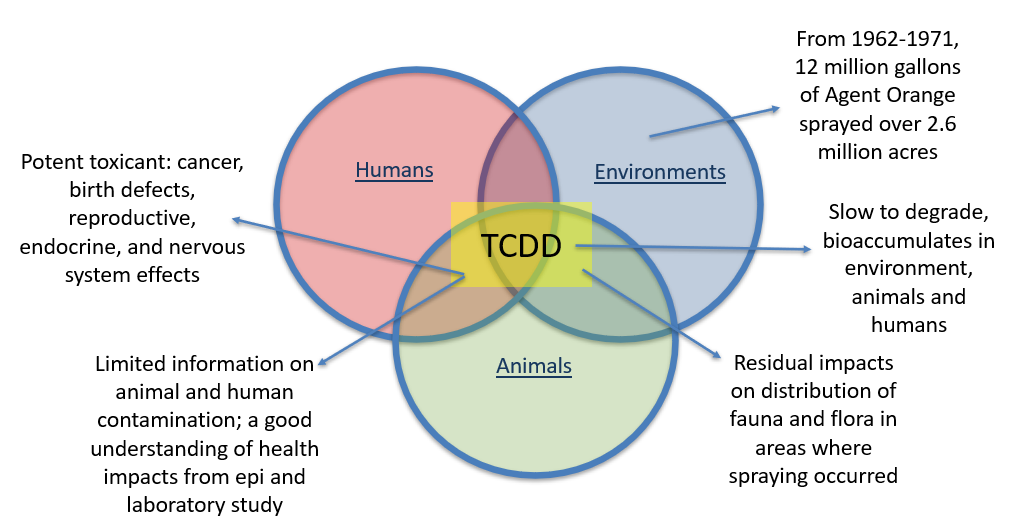 |
| Figure 1. The One Health Model as applied to a toxicant. a. Scope of TCDD exposures and impacts. b. This study’s TCDD contamination database (DCVT) organized into three domains of human, environmental, and biota. |
A literature review was conducted to compile findings from TCDD surveys in Viet Nam. The search employed PubMed, Google scholar, the Organohalogen Compounds database (http://dioxin20xx.org/organohalogen-compounds-database-search/) and Google. The search terms varied but always included “TCDD” and either “Viet Nam” or “Vietnam”. The search results were reviewed and reports that met the criteria of reporting measurements of TCDD within humans, animals, plants or environmental media such as soil or water were selected for inclusion. Given the intent to investigate the role of Agent Orange, an absolute criterion for inclusion was the measurement of TCDD concentrations. Investigations that reported TEQ but not TCDD concentrations were not included. In contrast, studies that reported TCDD concentrations but not TEQ or other congeners were considered to have met the criteria. The second essential criterion was that the measurements were made within the country of Viet Nam.
Three parallel databases, one for each domain (human, biota, environmental) are being constructed due to the varying fields needed to summarize the data. All databases include fields for citation, sample number, year the sample was obtained, year of the report, location as precisely as possible to facilitate subsequent geocoding, TCDD concentration, indication of whether results are lipid adjusted, TEQ, and % TCDD/TEQ. A number of fields describing the laboratory methodology are also included, although it is understood that some information will not be available. These fields will be critical for the reliability assessment. In addition, certain fields are special to the database. For instance, in the human database, there is a field that indicates whether the sample is from serum, breast milk, or adipose tissue. The biota database contains fields to indicate the species sampled, type of sample, whether the species is a food source, and whether the animal is wild or domestic.
Given the variety of sources of TCDD data, reliability of the measures will be assessed based on several of the laboratory-related fields in the database. For High Confidence measures, the laboratory is specified, the analysis method and protocol are described or identified, and the laboratory engages in documented quality control (QC) activities. Medium Confidence measures specify the laboratory, describe or identify the analysis method and protocol, but there is limited evidence of QC activity. Low Confidence measures are those where the laboratory is unknown OR the analytical method/protocol are not described or identified OR there is no evidence of QC activities.
Data was geocoded and mapped using QGIS software.
3. RESULTS AND DISCUSSION
Biota Domain: TCDD Contamination of Animals
This preliminary assessment of TCDD contamination of biota in Viet Nam focuses on animals, both wild and domestic, because levels tend to be higher than those detected in plants or fungi due to the higher percentage of lipids and the potential for bioaccumulation. We identified eleven (11) scientific papers that reported unique TCDD measurements in 381 different samples. Note that a sample could be taken from a pooled source of biological material from multiple animals or from a single individual. In Figure 2, TCDD concentrations are shown by taxonomic group. It should be recognized that these results are taken from a variety of studies and the TCDD analyses were not always done on the same tissue sample types as we will summarize in Figure 3. While lipid adjusted analyses are preferable, most of the samples measured TCDD in wet tissue. For example, of the total of 121 avian samples, 25 were lipid adjusted whereas 96 were not. These were not paired samples so the measurements of TCDD in lipid-adjusted and wet tissue for a given organ come from different studies. As expected, the lipid adjusted values were generally higher. The lowest arithmetic mean values (vertical blue bars) were found in mammals. The highest concentrations of TCDD were found in fish, with the unexpected observation that the mean from the lipid adjusted fish was lower than the non-lipid adjusted. This reflects the situation where the non-paired samples come from a variety of geographic locations and environments with varying levels of contamination. In fact, the highest concentration of TCDD reported was a non-lipid adjusted measurement of 3990 pg/g measured in a fish.
To provide a sense of scale, the arithmetic mean for lipid adjusted avian samples was 25.8 pg/g compared to 8.3 in the non-lipid adjusted. By comparison, total TEQ which reflects all major dioxins in addition to TCDD measured in a market basket survey of fish in the US reported concentrations of only 0.33 pg/g (Lorber et al., 2009). In the same survey, the lipid-adjusted concentrations in poultry in the US were 0.018 pg/g compared to 25.8 pg/g for the Viet Nam samples (Lorber et al., 2009).
 |
| Figure 2. TCDD concentration by taxonomic group (“Lipid” = lipid adjusted) |
KEY: 5% and 95% CI: • ; median: ǀ ; arithmetic mean: |
Figure 3 summarizes the same dataset as above but reports results by tissue type. As detailed above, some analyses were lipid adjusted while others were not. The highest levels were found in lipids reaching nearly 50,000 pg/g. A number of the analyses were from animal sources where the tissue analyte was not specified in the text of the report. Data described as “Other specified samples” are those where the source was specified but the numbers of measurements are not enough to classify separately; for instance, we have a single analysis from animal nails.
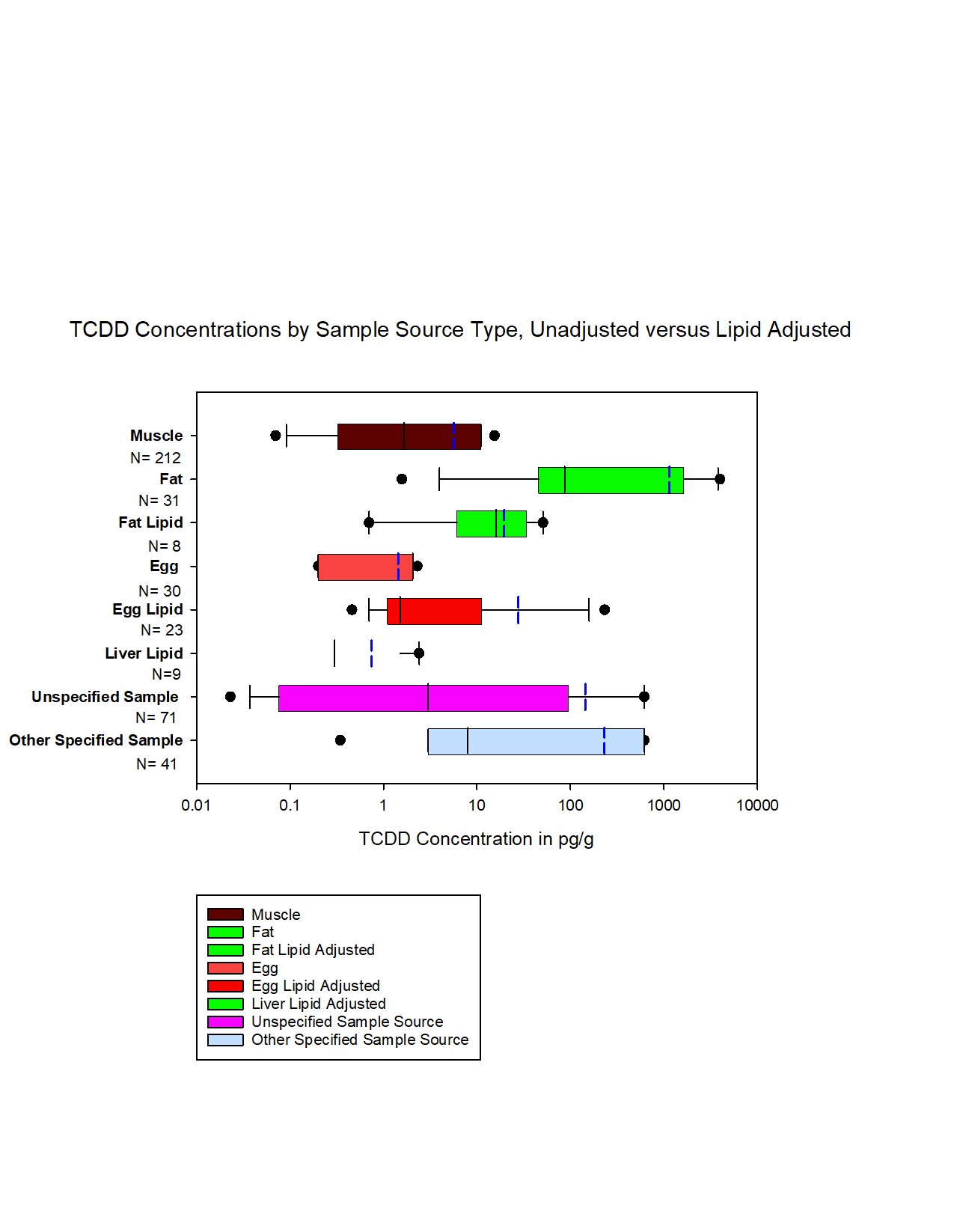 |
| Figure 3. TCDD concentration in animals in different tissues and organs (“Lipid” = lipid adjusted) |
KEY: 5% and 95% CI: • ; Mean: |
The mean TCDD concentration reported in eggs from Viet Nam was about 4 pg/g, approximately an order of magnitude higher than TCDD measured in eggs from the U.S. (in California) in the late 1990’s (Goldman et al., 2000).
To put this into perspective, the World Health Organization’s (WHO) tolerable daily intake (TDI) for TCDD is 1 - 4 pg per kg body weight per day. Therefore, for an average Viet Namese person who weighs 50 kg, their TDI would range from 50 to 200 pg/day. Assuming that the average chicken egg weighs 50 g and has a TCDD load of 8 pg/g (based on the non-lipid adjusted egg data), each egg would contain a total of 400 pg of TCDD, well over twice the tolerable daily intake for the average person in Viet Nam.
Human Domain: The geographic distribution Concentrations of TCDD
We used GIS methods to explore the geographic distribution of human contamination through time. We identified forty-four (44) papers reporting the concentration of TCDD in materials of human origin, principally blood serum and breast milk. These papers provided 541 entries with each being a TCDD measurement; measurements originated from individuals, the pooled results from many individuals, or in some instances the summary measures when neither the individual or pooled results were reported. Weighted averages were calculated for pooled and summary measures. TCDD concentrations ranged from non-detectable to 1648.5 pg/g lipid. After geocoding, we had 99 points that were used to create geospatial and temporal maps with QGIS software. The data was divided into pentiles to indicate the concentration intensity (Figure 4).
 |
| Figure 4. TCDD in human biological samples obtained between 1970 and 2017. |
The geospatial mapping showed that TCDD concentrations were higher in the southern and central provinces, a finding that is consistent with the spraying of Agent Orange. We suspect that human migration from these areas may have led to some of the slightly elevated levels in the North. For comparison purposes, the upper 95th percentile of TCDD concentrations measured in adults surveyed in the U.S. National Health and Nutrition Examination Survey (NHANES) in 2003-2004 was 5.2 pg/g.
4. CONCLUSION AND NEXT STEPS
This initial study provides an understanding of existing surveillance efforts in multiple species and sample types by highlighting the elevated levels of TCDD contamination found in animals, many of which are food sources along with showing the extensive geographic distribution of human exposure. Future analyses will combine the domains, examining geographic distribution of biota in association with human contamination. The One Health approach applied in this study will provide a better sense of relevant ecotoxicological aspects that may play a role in exposure and TCDD levels via food and environmental sources. Aggregating findings across species allows for an improved ecological view of TCDD accumulation throughout the life cycle and food chain. Compiling this data will help identify knowledge gaps where targeted surveillance may be needed and with combined with a conservation lens, permit assessment of TCDD risks regarding any impacts on endangered species.
Future work can build on this study, including filling in the geographic gaps where available data is limited. Prospective TCDD surveys can also consider opportunities to build in the One Health approach to conduct paired human, animal, and environmental sampling, or collect behavioral risk data on possible environmental and food practices that could affect TCDD levels. Steps to fingerprint TCDD to distinguish industrial from Agent orange sources will also allow for a greater understanding of the sources and persistence of TCDD in different regions.
REFERENCES
1. Ngo AD, Taylor R, Roberts CL, Nguyen TV (2006) Association between Agent Orange and birth defects: systematic review and meta-analysis, International Journal of Epidemiology, 35:1220–1230, https://doi.org/10.1093/ije/dyl038
2. Buttke DE (2011) Toxicology, environmental health, and the “One Health” concept. J Med Toxicol. 7(4):329-32, doi: 10.1007/s13181-011-0172-4.
3. CDC (2020) Biomonitoring Summary: Dioxin-Like Chemicals: Polychlorinated Dibenzo-p-dioxins, Polychlorinated Dibenzofurans, and Coplanar and Mono-ortho-substituted Polychlorinated Biphenyls
https://www.cdc.gov/biomonitoring/DioxinLikeChemicals_BiomonitoringSummary.html Accessed December 8, 2021
4. Goldman LR, Harnly M, Flattery J, Patterson DG Jr, Needham LL (2000) Serum polychlorinated dibenzo-p-dioxins and polychlorinated dibenzofurans among people eating contaminated home-produced eggs and beef. Environ Health Perspect. 108:13-19, doi:10.1289/ehp.0010813
5. Lorber M, Patterson D, Huwe J, Kahn H (2009) Evaluation of background exposures of Americans to dioxin-like compounds in the 1990s and the 2000s. Chemosphere 77: 640-651.
6. Stellman, J., Stellman, S., Christian, R. et al. (2003) The extent and patterns of usage of Agent Orange and other herbicides in Vietnam. Nature 422: 681–687, https://doi.org/10.1038/nature01537
7. WHO, FAO, OIE, and UNEP. Tripartite and UNEP support OHHLEP’s definition of One Health. Joint Tripartite and UNEP Statement. December 1, 2021. https://www.who.int/news/item/01-12-2021-tripartite-and-unep-support-ohhlep-s-definition- of-one-health
8. Zook DR, Rappe C (1994) Environmental Sources, Distribution, and Fate of Polychlorinated Dibenzodioxins, Dibenzofurans, and Related Organochlorines. In: Schecter A. (eds) Dioxins and Health. Springer, Boston, MA. https://doi.org/10.1007/978-1-4899-1462-0_3.
Jean Grassman1, Lauren Cybulska1, Fiona Conway1, Catherine Machalaba2
1Occupational, Environmental and Geospatial Health Sciences, City University of New York Graduate School of Public Health and Health Policy, 55 West 125th Street, New York, NY, 10027 USA 2EcoHealth Alliance, New York, NY, US.




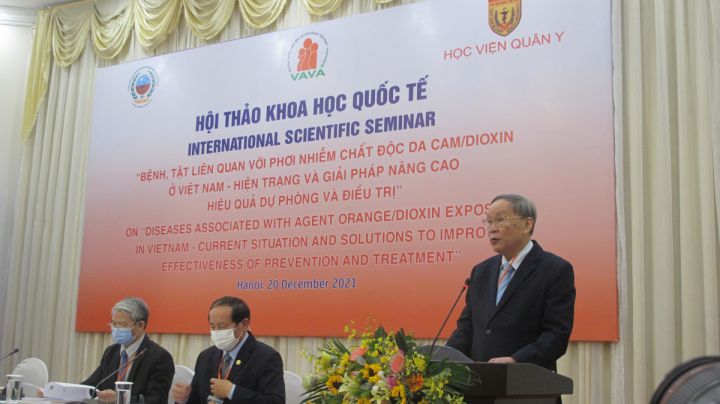

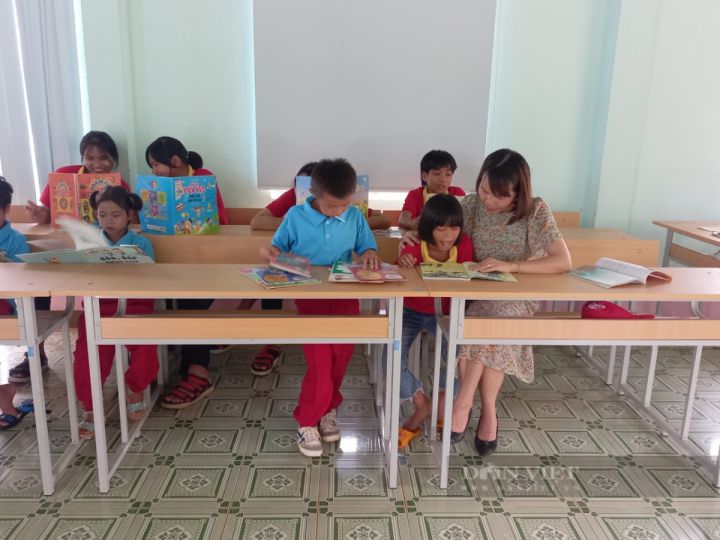



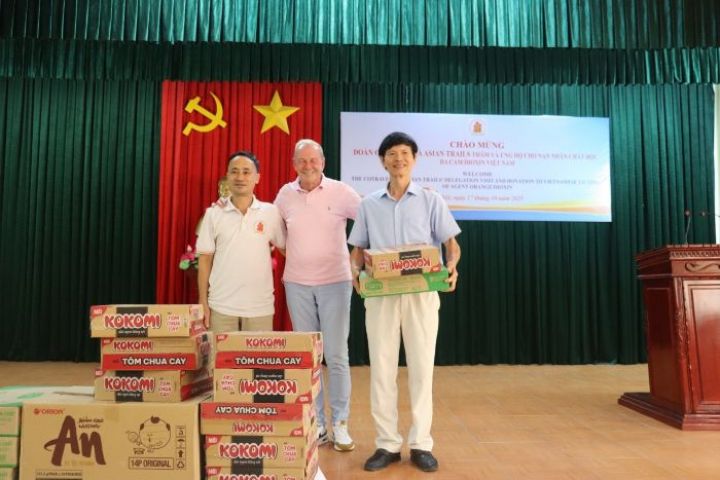












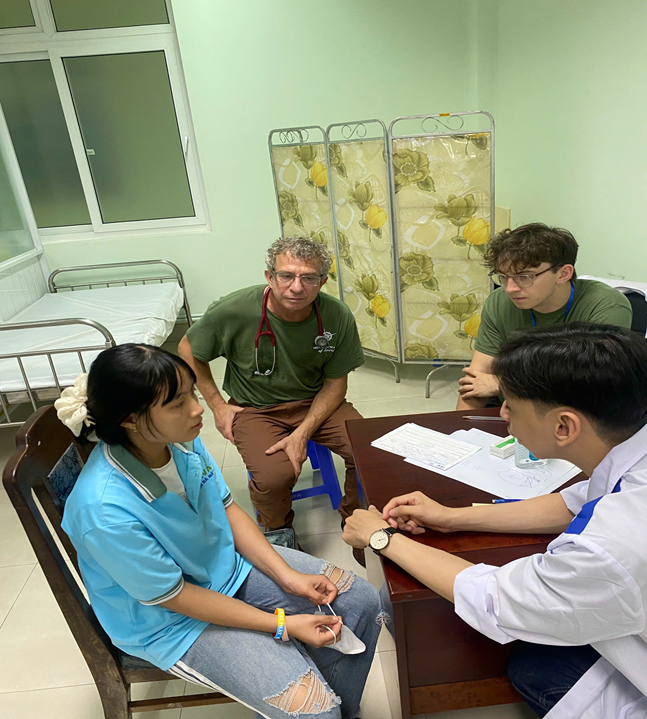
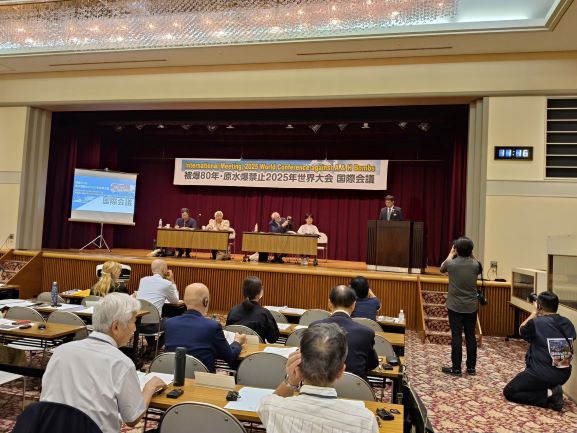
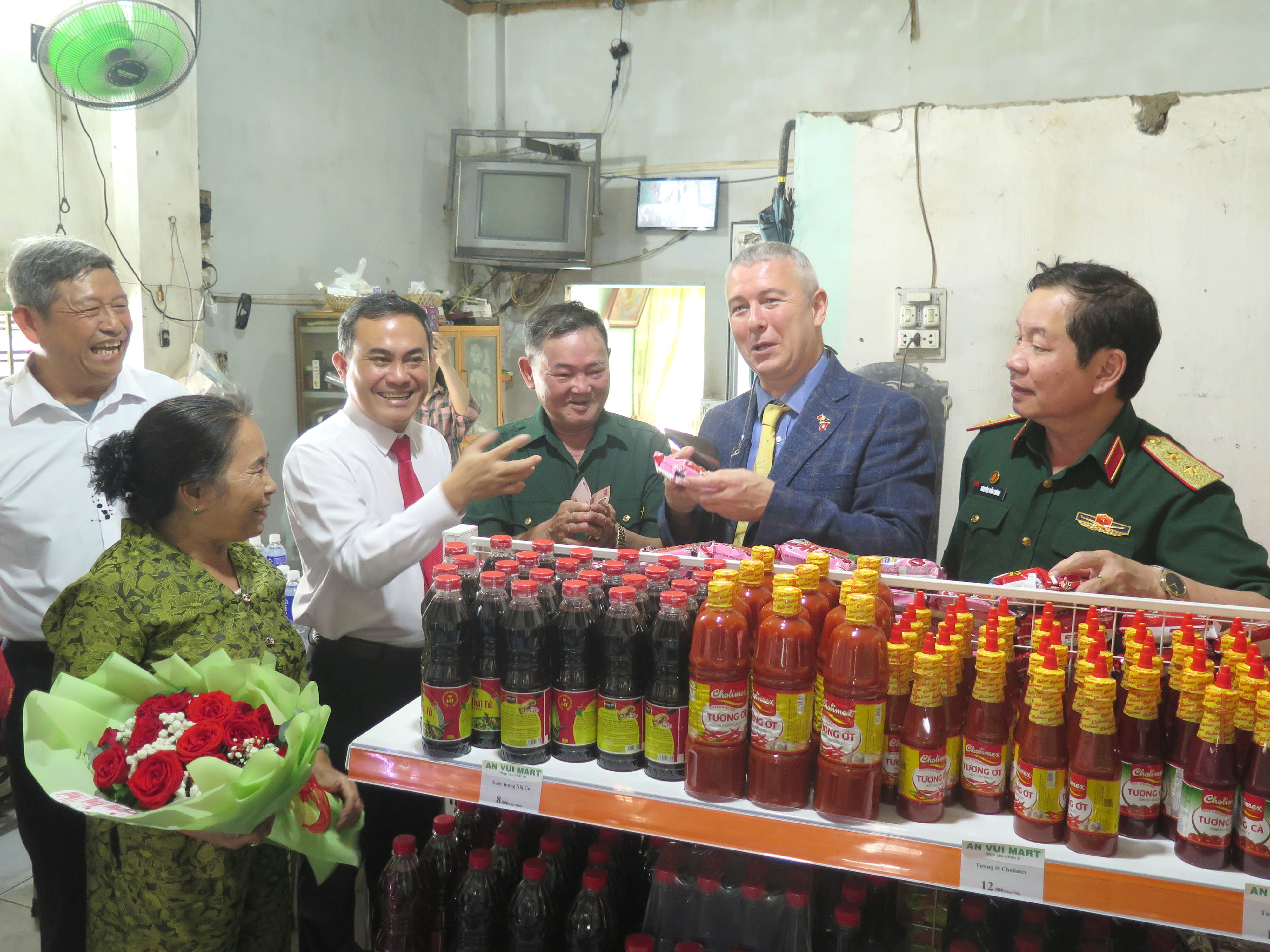


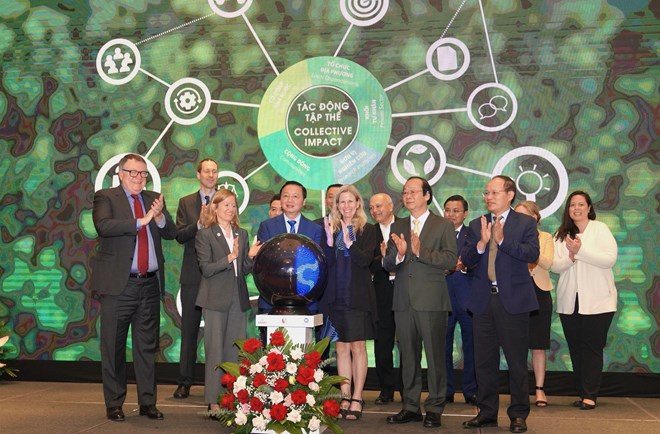




.jpg)
Comment